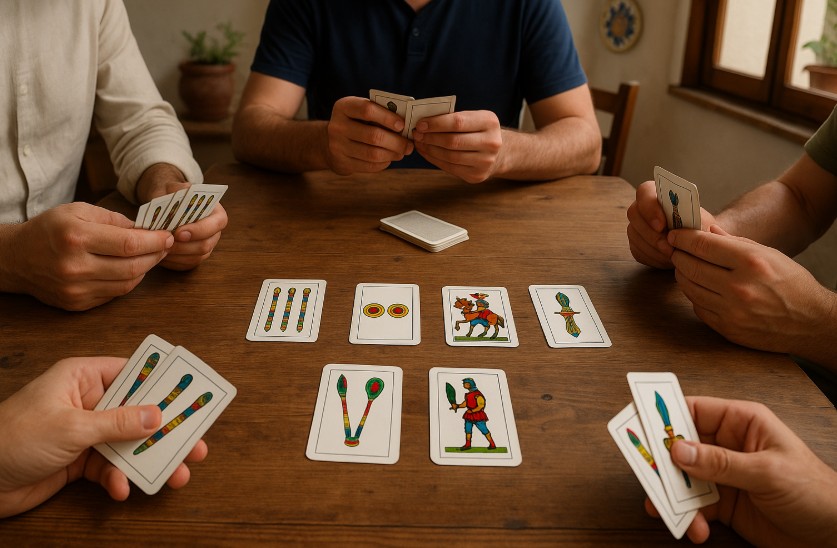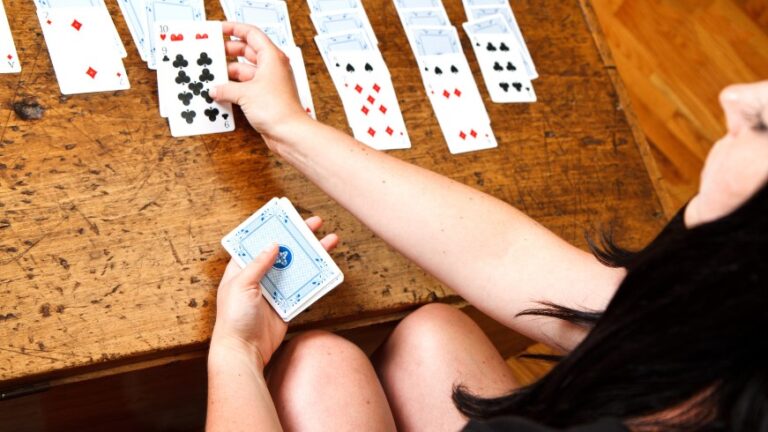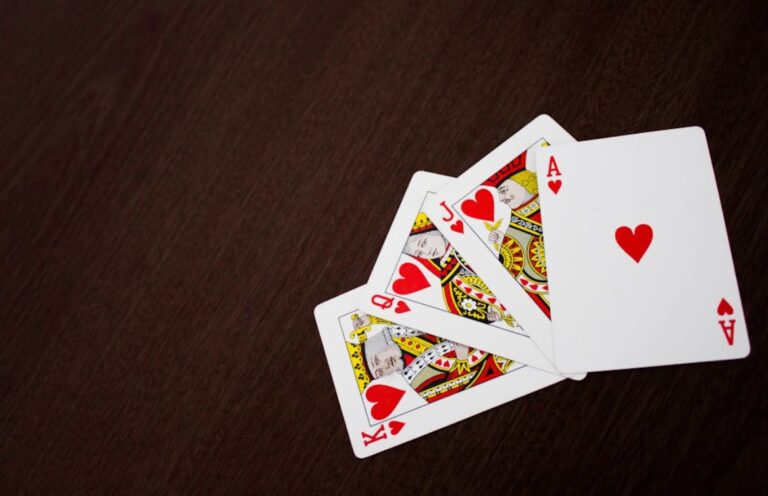Briscola is a classic Italian card game renowned for its strategic depth and enduring appeal. Played with a 40-card deck and enjoyed across Europe, it offers a unique twist on traditional trick-taking mechanics.
Suitable for two to six players, Briscola blends accessible rules with tactical gameplay, making it a favourite in both casual and competitive settings.
This guide explores everything from the rules and scoring system to advanced strategies and variations, providing a complete overview for beginners and experienced players alike.
What Is The Briscola Card Game And Where Did It Originate?
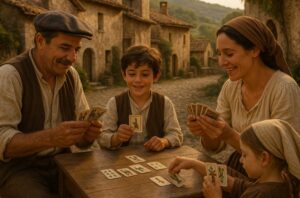
The Briscola card game is a traditional trick-taking card game that has remained popular throughout Italy and many Mediterranean countries.
It is considered one of Italy’s most significant card games, often played alongside Scopa and Tressette. The game originated as a variant of Brusquembille, a French game that eventually evolved into Briscola.
Briscola’s enduring popularity is partly due to its simple rules and broad accessibility. Over time, it spread beyond Italy to Spain, Portugal, the Balkans, and other parts of Europe, leading to regional variations like Briškula, Bisca, and Briscola Chiamata.
It is a game suitable for anywhere between two and six players and uses a 40-card Italian deck. It can also be played with a modified Anglo-French deck, ensuring flexibility across cultures.
Briscola’s format allows both casual and competitive play, from family settings to tournament tables.
What Type Of Cards Are Used To Play Briscola?
The standard deck used in Briscola is the Italian 40-card deck. This deck consists of four suits: Coins (Denari), Swords (Spade), Cups (Coppe), and Clubs (Bastoni).
Each suit contains cards numbered from one to seven, followed by three face cards: Fante (Jack), Cavallo (Knight), and Re (King).
Each card has a point value, and winning requires accumulating more points than your opponents.
When using a modern Anglo-French deck, the 8s, 9s, and 10s are removed, resulting in a 40-card pack that mimics the traditional structure. In games involving three or six players, specific twos are removed to maintain even distribution.
In certain regions, the card illustrations and names may vary slightly, but the core structure and values remain the same.
Briscola Card Ranks And Values
| Card Name | Rank Order | Point Value |
| Ace (Asso) | Highest | 11 |
| Three (Tre) | Second Highest | 10 |
| King (Re) | Third | 4 |
| Knight (Cavallo) | Fourth | 3 |
| Jack (Fante) | Fifth | 2 |
| Cards 2–7 (except 3) | Lowest | 0 |
The total number of points in the deck is 120. The aim is to capture as many points as possible through strategic card play.
How Do You Set Up And Start A Briscola Game?
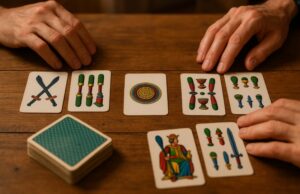
The game setup depends on the number of players involved. Briscola supports:
- Two-player duels
- Three-player individual games
- Four or six-player partnership games (teams of two or three)
To begin, the dealer shuffles the deck and deals three cards to each player. The next card is placed face-up on the table.
This is the Briscola or trump card, and its suit becomes the dominant suit for that round. The rest of the deck is placed face-down, sometimes partially covering the Briscola card.
In four-player partnership games, players may reveal their hands to teammates before the first trick is played. Play always proceeds anti-clockwise.
Each player draws a card after a trick, beginning with the winner of the previous trick. Drawing continues until the deck is exhausted.
What Are The Rules Of The Briscola Card Game?
The rules of the Briscola card game are simple to understand but allow for significant strategic complexity during play. It is a trick-taking game, meaning players compete to win rounds (or “tricks”) by playing the highest-ranking card according to specific rules.
Briscola can be played with two, three, four, five, or six players, with minor rule adjustments depending on the number of participants. The most common formats are the two-player individual game and the four-player partnership game, where teammates work together to accumulate points.
Dealing And Trump Card
To begin a game of Briscola:
-
The dealer shuffles and deals three cards to each player.
-
One card from the deck is placed face-up on the table.
-
The rest of the deck is placed face-down, with the face-up card partly visible underneath.
-
The suit of the face-up card becomes the Briscola – or trump suit – for the entire game.
This Briscola card plays a key role in determining which cards win tricks throughout the game.
Gameplay Sequence
Once the cards are dealt and the Briscola is revealed, the player to the dealer’s right leads the first trick. Play continues in an anti-clockwise direction. Each player places one card face-up on the table in turn.
The winner of the trick is determined by the following rules:
-
If one or more cards of the Briscola (trump) suit are played, the highest Briscola wins the trick.
-
If no Briscola cards are played, the highest card of the suit that was led wins the trick.
The winning player collects all the cards from the trick and places them face-down in a personal pile. In partnership games, one player may be designated to collect tricks for the team.
After each trick:
-
Players draw one card from the face-down deck, starting with the player who won the trick and continuing anti-clockwise.
-
The player who won the previous trick leads the next trick.
This process continues until all cards have been drawn and played, at which point the round ends and scores are calculated.
Suit-Following Rules
One of the most distinctive aspects of Briscola is that players are not required to follow suit. In most trick-taking games (like Hearts or Bridge), players must play a card of the same suit as the first card played in the trick. In Briscola, however, players may play any card from their hand, regardless of suit.
This rule significantly increases the game’s strategic depth. Players can choose to discard low-value cards, play powerful trump cards to secure tricks, or bait their opponents into wasting strong cards.
Example Of Trick Resolution
Let’s say the Briscola (trump suit) is Cups. A player leads a 7 of Coins, the next player plays a 3 of Coins, the third player plays an Ace of Swords, and the final player plays a 2 of Cups.
-
Even though the Ace is normally the highest value card, the 2 of Cups wins because it is the only Briscola (trump) card in the trick.
-
Had there been no Briscola cards, the 3 of Coins would have won because it is the highest-ranking card in the suit that was led (Coins).
This example highlights how trump cards can overturn the usual hierarchy of card values.
Special Rule: Swapping The Briscola
Before the first trick is played, the player who holds the two of Briscola (the lowest card in the trump suit) has the option to swap it with the face-up Briscola card on the table.
This optional rule is sometimes used in informal or regional versions of the game. The swap must occur before any cards are played.
In some variants, this rule adds a subtle strategic advantage to holding the low Briscola early in the game.
Direction Of Play
Briscola is always played in an anti-clockwise direction. This applies to card play, drawing new cards, and determining the order of turns. This directional rule reflects the game’s Mediterranean origins, where anti-clockwise play is the traditional norm.
How Is The Scoring System Structured In Briscola?
Scoring in Briscola is straightforward. Each trick taken may contain point-value cards. The player or team that accumulates more than 60 points wins the round. If both sides score 60 points, the round is a draw.
Scoring Breakdown
| Result | Outcome |
| 61–90 points | Regular win (1 point) |
| 91–119 points | Strong win (2 points) |
| 120 points | Full sweep (3 points) |
| 60 points | Draw |
Some game variants involve multiple rounds with cumulative scoring. For example, in tournament formats or extended matches, players may compete to reach a total of 12 points over a series of rounds.
What Strategies Can Help You Win At Briscola?
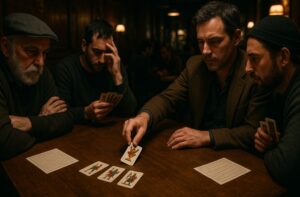
Winning in Briscola requires more than luck. A few basic strategies can significantly improve a player’s chances.
- Track high-value cards played, particularly the Ace and Three
- Use trump cards (Briscole) sparingly, preferably to win valuable tricks
- If playing in a partnership, coordinate plays subtly or use pre-agreed signals
- Avoid wasting strong cards on low-value tricks unless it’s a tactical sacrifice
In team-based games, non-verbal communication can also play a crucial role. Traditional signals between teammates include facial gestures and movements. For example:
- Raising eyebrows could indicate holding a King
- Licking lips might mean possession of a Jack
- Shrugging one shoulder may signal a Knight
Although these practices are informal and optional, they are popular in social games.
Are There Different Variations Of Briscola Played Today?
Briscola has spawned numerous regional and cultural variations. These adapt the core gameplay to suit different group sizes, rule preferences, or levels of complexity.
Common Variations Include:
- Briscola Chiamata: A five-player version with bidding and hidden partnerships
- Briscolone: A two-player variation played without trump suits
- Briscola Scoperta: All players’ cards are visible to everyone, adding strategic depth
- La Conquista (Black Hand): If a player starts with the Ace, Three, and King of Briscola, they win automatically
In Briscola Chiamata, gameplay begins with a bidding phase where players compete to declare the Briscola suit and choose a secret partner by naming a specific card. The actual game plays similarly to standard Briscola, but alliances are revealed gradually through play.
Can Briscola Be Played Online Or On Mobile Apps?
Digital versions of Briscola have helped preserve and expand the game’s popularity. Both browser-based and mobile versions are widely available, providing options for casual practice and competitive play.
Available Platforms:
- Dedicated apps on Android and iOS
- Web platforms with multiplayer modes
- Online tutorials for new players
- AI opponents for skill-building
Some platforms allow players to customise rules and play various international versions, such as Bisca or Briscola Chiamata. Multiplayer lobbies and rating systems are also common, creating a lively online community.
How Does Briscola Compare To Other Traditional Card Games?
Compared to games like Scopa and Tressette, Briscola offers greater tactical freedom due to its lack of suit-following rules. It is easier to learn than Tressette and typically less arithmetic-focused than Scopa.
Briscola’s appeal lies in its balance of luck and skill. It rewards memory, anticipation, and psychological play but doesn’t require complex scoring or deep memorisation like some other trick-taking games. For this reason, it is often one of the first traditional card games children in Italy learn.
What Terminology Should Every Briscola Player Know?
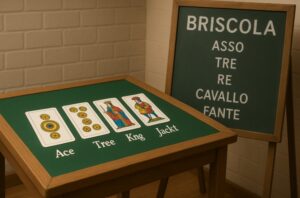
Understanding the basic terminology used in Briscola enhances gameplay, especially when learning from Italian resources or playing with experienced individuals.
- Briscola: The trump suit of the game
- Presa: A trick
- Mano: A round or hand of play
- Segnale: A signal used in team games
- Scartare: To discard a card
- Fare Cappotto: Achieving all 120 points in a round
- Mano Nera / La Conquista: An automatic win with the Ace, Three, and King of Briscola
Familiarity with these terms is helpful, particularly when playing variants or reading traditional rulebooks.
Conclusion
For anyone interested in classic card games with a strong strategic component and rich cultural heritage, Briscola is an excellent choice. Its accessibility makes it easy to learn, while its tactical layers ensure that no two games are alike.
Whether you’re a beginner or an experienced card player, the Briscola card game offers a timeless and engaging experience.
FAQs about the Briscola Card Game
What is the minimum number of players required to play Briscola?
Briscola can be played with as few as two players. However, it also accommodates up to six, with four and six-player games commonly played in partnerships.
Is Briscola suitable for children?
Yes, Briscola is family-friendly and suitable for children aged 8 and above, especially as it teaches logical thinking and simple arithmetic.
Do players have to follow suit in Briscola?
No. Unlike many card games, players are not required to follow suit, which opens up various strategic possibilities.
Can I play Briscola using a regular deck of cards?
Yes, a standard 52-card deck can be modified by removing the 8s, 9s, and 10s, leaving a 40-card deck that mimics the Italian version.
Are signals allowed in all Briscola games?
Signals are typically allowed in partnership versions of the game but only if all players agree beforehand. They are often used in informal or traditional play.
What happens in the event of a tie?
If both players or teams score exactly 60 points, the game is considered a draw and is usually replayed.
Is Briscola more about luck or skill?
While luck plays a role in the cards dealt, long-term success in Briscola depends heavily on skill, memory, and strategic play.

